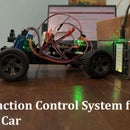Introduction: Simple Arduino Trigger for DSLR
In this instructable, we are going to make a very simple DSLR camera trigger. which can be used for multiple purposes like:
- Time lapse video,
- High-speed photography (ex. water drop photography),
- To make camera trap.
what you would need:
- Arduino (UNO, nano or anything you have work.)
- camera remote,
- 2 resistor of 5k and 1.5k
- few jumper wires
Step 1: How Camera Shutter Release Works:
camera shutter release connects to DSLR which has 3 wires coming out.
As can be seen in the image each wire is connected to a plate. if we press the button half way two upper plates connect together and if we press it completely second and third plate also come into contact.
So here we are using Arduino to make these connections.
Note: I have checked these values on my canon Eos 1100.
Step 2: Making Circuit for Trigger:
here we are making a trigger only so we are not using the first plate which is used for focusing, but 2nd and 3rd only which are used for the trigger.
initially, 2nd plate is at GND and 3rd at 3.3 V . when we press button 2nd plate get in contact with plate 3 and the 3rd plate is pulled down to GND it triggers the shutter.
here,
we are using pin 13 for triggering (just because it has a LED), when we set it to high it gives voltage value of 5V, but our camera works on 3.3V so we would use voltage divider to set that value to 3.3 v. As we set this pin to ground or LOW it trigger the shutter.
Step 3: Using Shutter Release:
- Time Lapse video:
it is very easy to use this setup for time lapse value. first, you need to calculate the time delay required for your time lapse. for an example, if you need the delay of 20 seconds. set a pin to high and wait for 20 seconds and then set a pin to low and again wait for 200 to 300 milliseconds of time. - High-speed photography:
Here to capture a perfect moment you need to have LED and photosensor pair, as a water drop or any object pass from in between change in sensor reading is detected by Arduino and after some specified delay, it triggers the shutter. - camera trap:
to detect any motion PIR sensor can be used, as it detects any motion it sends the signal which can be captured by Arduino and use to trigger the camera.













